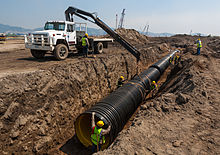
High-density polyethylene
High-density polyethylene (HDPE) or polyethylene high-density (PEHD) is a thermoplastic polymer produced from the monomer ethylene. It is sometimes called "alkathene" or "polythene" when used for HDPE pipes.[1] With a high strength-to-density ratio, HDPE is used in the production of plastic bottles, corrosion-resistant piping, geomembranes and plastic lumber. HDPE is commonly recycled, and has the number "2" as its resin identification code.
In 2007, the global HDPE market reached a volume of more than 30 million tons.[2]
Properties
HDPE is known for its large strength-to-density ratio.[3] The density of HDPE can range from 930 to 970 kg/m3.[4] Although the density of HDPE is only marginally higher than that of low-density polyethylene,[5] HDPE has little branching, giving it stronger intermolecular forces and tensile strength than LDPE. The difference in strength exceeds the difference in density, giving HDPE a higher specific strength.[6] It is also harder and more opaque and can withstand somewhat higher temperatures (120 °C/248 °F for short periods). High-density polyethylene, unlike polypropylene, cannot withstand normally required autoclaving conditions. The lack of branching is ensured by an appropriate choice of catalyst (e.g., Ziegler–Natta catalysts) and reaction conditions.
The physical properties of HDPE can vary depending on the molding process that is used to manufacture a specific sample; to some degree a determining factor are the international standardized testing methods employed to identify these properties for a specific process. For example, in Rotational Molding, to identify the environmental stress crack resistance of a sample, the Notched Constant Tensile Load Test (NCTL) is put to use.[7]
Owing to these desirable properties, pipes constructed out of HDPE are ideally applicable for potable water,[8] and waste water (storm and sewage).[9]
Applications
HDPE is resistant to many different solvents and has a wide variety of applications:
• 3D printer filament
• Arena board (puck board)[10]
• Backpacking frames
• Ballistic plates
• Banners
• Bottle caps
• Boats
• Chemical-resistant piping
• Coax cable inner insulator
• Conduit protector for electrical or communications cables
• Corrosion protection for steel pipelines
• Electrical and plumbing boxes
• Far-IR lenses
• Fireworks
• Folding chairs and tables
• Food storage containers
• Fuel tanks for vehicles
• Geomembrane for hydraulic applications (such as canals and bank reinforcements) and chemical containment
• Geothermal heat transfer piping systems
• Heat-resistant firework mortars
• Housewrap (Tyvek)
• Hovercraft: The material is too heavy and dense for such craft but is still used occasionally
• Lasts for shoes
• Microwave telescope windows
• Natural gas distribution pipe systems[11]
• Piping for fluid, slurry and gas purposes
• Plastic bags
• Plastic bottles suitable both for recycling (such as milk jugs) or re-use
• Plastic lumber
• Plastic surgery (skeletal and facial reconstruction)[12]
• Potable water mains[8]
• Root barrier
• Sewage mains[9]
• Snowboard rails and boxes
• Stone paper
• Storage sheds
• Swimming pool installation
• Telecom ducts[13]
• Water pipes for domestic water supply and agricultural processes [8]
• Wood plastic composites (utilizing recycled polymers)
HDPE is also used for cell liners in subtitle D sanitary landfills, wherein large sheets of HDPE are either extrusion welded or wedge welded to form a homogeneous chemical-resistant barrier, with the intention of preventing the pollution of soil and groundwater by the liquid constituents of solid waste.
HDPE is preferred by the pyrotechnics trade for mortars over steel or PVC tubes, being more durable and safer: HDPE tends to rip or tear in a malfunction instead of shattering and becoming shrapnel like the other materials.
Milk bottles, jugs, and other hollow goods manufactured through blow molding are the most important application area for HDPE, accounting for one-third of worldwide production, or more than 8 million tonnes.
Above all, China, where beverage bottles made from HDPE were first imported in 2005, is a growing market for rigid HDPE packaging, as a result of its improving standard of living. In India and other highly populated, emerging nations, infrastructure expansion includes the deployment of pipes and cable insulation made from HDPE.[2] The material has benefited from discussions about possible health and environmental problems caused by PVC and polycarbonate associated Bisphenol A, as well as its advantages over glass, metal, and cardboard.
HDPE pipe
HDPE pipe is a type of flexible plastic pipe used for fluid and gas transfer and is often used to replace ageing concrete or steel mains pipelines. HDPE (High Density Poly-Ethylene) material is a polyethylene thermoplastic made from petroleum, and its high level of impermeability and strong molecular bond makes it suitable for high pressure pipelines. HDPE pipe is used across the globe for water mains, gas mains [1], sewer mains, slurry transfer lines, rural irrigation, fire system supply lines, electrical and communications conduit, stormwater and drainage pipes, and other applications.
Benefits
The toughness and resistance to chemicals of polyethylene, as well as the corrosion resistance and low weight have contributed to its growing use in situations where cost-effective and durable fluid and gas piping systems are required. “PE piping has been used for water and other fluids in Europe and America since the 1950’s due to its durability, leak free joints, resistance to corrosion, and long-term cost-effectiveness". [2] HDPE pipe can be joined by butt welding, electrofusion welding, socket welding or extrusion welding. These joints heat the pipe during the joining process, creating a completely homogenous joint so the weld becomes as strong, or stronger than the existing pipe on either side of the weld. There is no need to use rubber seals or jointing chemicals, as is used for joining PVC pipe, which cause environmental health issues and increase the chance of failure over time. PE is less likely to have problems with root intrusion, and provides integrity for the pipeline, even when installed in unstable soils.
Due to the fusion welded system, the need for anchors or thrust restraint blocks are eliminated, as the joints become fully end load resistant, reducing costs for material and installation time. This also allows for safer excavation close to the pipeline in future, which is particularly important for high pressure gas pipelines. Coils of PE Pipe make trench-less installation safer and less intrusive on the surrounding environment. HDPE Pipe Systems are available for many applications, providing for standard trenching of water mains, fire ring mains, sewer mains, and gas mains pipelines, as well as horizontal drilling for electrical and telecommunications conduits. [3] HDPE Systems are cost effective to install and have long term maintenance cost savings, and also allow for cheaper installation methods, such as HDD (Horizontal Directional Drilling), Slip-lining, Pipe Bursting, Floating or Submerged Pipe.
HDPE pipe is very durable and flexible and can be bent on site to a radius 25x the nominal pipe diameter - for SDR11 and SDR17 pipe, at or below 20°C ambient temperature. This provides major cost savings, when compared to different pipe systems, some of which require glued fittings, restraints or thrust blocks for even minor changes in direction. Because the high impact resistance and flexibility of HDPE pipe, it is well suited to installation in dynamic soils including in earthquake prone areas. HDPE pipe has very high flow capacity, because of its smooth bore and end-to-end jointing methods. HDPE pipe doesn't corrode in the environment, and will maintain its flow capabilities over time, unlike ferrous piping systems, which will rust and build up internal resistance to fluid flowing through it.
Because food grade polyethylene virgin material is used to fabricate HDPE pipes, they are safe for the transfer of potable water, providing any initial debris has been flushed out. HDPE pipe is resistant to many chemicals, facilitating its use in process plants or around corrosive or acidic environments, without needing to pay for protective coatings or galvanising, as is required on steel pipes. As HDPE has a very low thermal conductivity, it can maintain more uniform temperatures compared to metal pipes, when carrying fluids, which will greatly reduce any need for insulation to control condensation around the pipeline.
Manufacture
To make pipe lengths, HDPE material is heated and extruded through a die, which determines the diameter of the pipeline. The wall thickness of the pipe is determined by a combination of the size of the die, speed of the screw and the speed of the haul-off tractor. Polyethylene pipe is usually black in color due to the addition of 3-5% of carbon black being added to the clear polyethylene material. The addition of carbon black creates a product which is UV resistant. Other colours are available but are less common. Coloured or striped HDPE Pipe is usually 90-95% black material, with just a coloured skin or stripe on the outside 5%.
The following shows the process for HDPE Pipe Extrusion:
Polyethylene raw material is pulled from a silo, into the hopper dryer, which removes any moisture from the pellets. Then it is pulled by a vacuum pump into the blender, where it is heated by a barrel heater. The PE material becomes molten at around 180 degrees Celsius, allowing it to be fed through a mould/die, which shapes the molten material into a circular shape. After coming through the die, the newly formed pipe quickly enters the 3-4 cooling tanks, which submerge or spray water at the pipe exterior, each one reducing the temperature of the pipe by 10-20 degrees. Because Polyethylene has a high specific heat capacity, the pipe must be cooled in stages, to avoid deforming the shape, and by the time it reaches the 'haul-off tractor', it is hard enough to be gently pulled by the 2-3 belts. A digital or powder printer, the size, type, date and manufacturers name is printed on the side of the pipe. It is then cut by a saw cutter, either into lengths of 3, 6, 12, or 24 meters, or it is coiled to 50m, 100m, 200m lengths on a coiler.
A different die is used for striped HDPE Pipe, which has small channels that the coloured material runs through, just before it is pushed through the die. This means the stripes are formed as an integral part of the pipe and are not likely to separate from the main pipe body. Co-extruded, or Co-ex HDPE pipe, has a second extrusion screw which adds an extra skin of colour around the black HDPE Pipe, this allows the pipe to be coloured on the outside, for identification or thermal cooling requirements.
Uses
An example of the durability of HDPE Pipe is the 600m long HDPE boom used for the Ocean Cleanup project. The HDPE pipeline is being released into the ocean to clean up the Great Pacific Garbage Patch.
HDPE Pipe has been used in rural and mining environments in Australia for over 50 years, proving to be a very durable and effective means of fluid and gas transfer.
Life expectancy
Although HDPE pipe is often estimated to last 50 years, they are in fact more likely to have life expectancies of 100 years. PIPA (Plastics Industry Pipe Association) and the Plastic Pipe Institute (PPI) have written technical white papers on HDPE design life. The PIPA paper is called 'Life Expectancy for Plastics Pipes' which mentions that due to the fifty-year stress regression data [5], people falsely assume that plastic pipe systems' life expectancy is only fifty years. In fact, these pipe systems can be reasonably expected to last up to or more than 100 years [5]. In Australia, PE pipes and PE fittings were introduced during the mid-1900’s, mainly for irrigation or water supply, but also for gas, fuel, and other industrial applications. The use of this 50-year time interval, leads to a misunderstanding that it represents a 50-year pipe life. For pipe systems that have been correctly manufactured and installed, the actual life can't be predicted, but can be expected to be over 100 years until major rehabilitation is needed.



